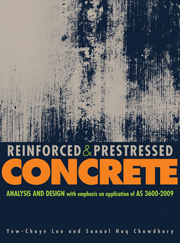Book contents
- Frontmatter
- Contents
- Preface
- Acknowledgements
- Notation
- Acknowledgements for tables and diagrams
- Acronyms and abbreviations
- Part I Reinforced concrete
- 1 Introduction
- 2 Design properties of materials
- 3 Ultimate strength analysis and design for bending
- 4 Deflection of beams and crack control
- 5 Ultimate strength design for shear
- 6 Ultimate strength design for torsion
- 7 Bond and stress development
- 8 Slabs
- 9 Columns
- 10 Walls
- 11 Footings, pile caps and retaining walls
- Part II Prestressed concrete
- Appendix A Elastic neutral axis
- Appendix B Critical shear perimeter
- Appendix C Development of an integrated package for design of reinforced concrete flat plates on personal computer
- Appendix D Strut-and-tie modelling of concrete structures
- Appendix E Australian Standard precast prestressed concrete bridge girder sections
- References
- Index
6 - Ultimate strength design for torsion
from Part I - Reinforced concrete
- Frontmatter
- Contents
- Preface
- Acknowledgements
- Notation
- Acknowledgements for tables and diagrams
- Acronyms and abbreviations
- Part I Reinforced concrete
- 1 Introduction
- 2 Design properties of materials
- 3 Ultimate strength analysis and design for bending
- 4 Deflection of beams and crack control
- 5 Ultimate strength design for shear
- 6 Ultimate strength design for torsion
- 7 Bond and stress development
- 8 Slabs
- 9 Columns
- 10 Walls
- 11 Footings, pile caps and retaining walls
- Part II Prestressed concrete
- Appendix A Elastic neutral axis
- Appendix B Critical shear perimeter
- Appendix C Development of an integrated package for design of reinforced concrete flat plates on personal computer
- Appendix D Strut-and-tie modelling of concrete structures
- Appendix E Australian Standard precast prestressed concrete bridge girder sections
- References
- Index
Summary
Introduction
Origin and nature of torsion
Torsion is a three-dimensional action; it is the moment about the longitudinal axis of the structural member. Occasionally, torsional moment is also referred to as twisting moment or torque.
In a three-dimensional structure, there are numerous situations in which torsion occurs. Figure 6.1(1) shows two typical cases.
For the case of the cantilever bent beam or bow girder in Figure 6.1(1)a, the torsional moment (T) is produced by the transverse load (P) acting eccentrically with respect to the axis of the beam. As it is a statically determinate structure, adequate design for torsion is vitally important — collapse of the system will result if failure in torsion occurs.
The grillage system shown in Figure 6.1(1)b is often used for beam-and-slab floor structures. The system is statically indeterminate. Torsion of the girder is a result of the unbalanced end moments at C of the two cross beams spanning in the z-direction. Note that for convenience, torsional moments may be indicated in the x–y plane by double-headed arrows following the right-hand screw rule. As the system is statically indeterminate, failure of beam AB in torsion would not automatically mean collapse of the grillage. However, serious serviceability problems of the beam (torsional cracking) can be expected as well as the redistribution of bending moments in the two cross beams (DC and CE).
- Type
- Chapter
- Information
- Reinforced and Prestressed ConcreteAnalysis and Design with Emphasis on Application of AS3600-2009, pp. 123 - 135Publisher: Cambridge University PressPrint publication year: 2010



